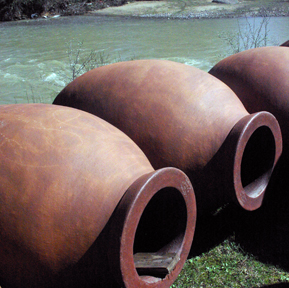After wishing and planning, I purchased a qvevri while in Western, Georgia. I’ll have to measure the size of the qvevri when I get it back to Maryland; however, it looks to be about 20 liters. The qvevri was not waxed, so I will also have to coat it with bees wax when I return home. Kathy’s brother owns an apiary in Upstate New York, so obtaining a quality beeswax is not a challenge.
I bought the qvevri from Zaliko Bodjadze near the village of Makatubani. It is rumored that Zaliko is one of the best qvevri makers in Georgia. There are few potters making qvevri in Georgia. Hopefully with qvevri making being added to the UNESCO list of intangible cultural heritage, the number of qvevri makers will increase.
My next challenge is to get the qvevri back to Maryland in one piece. At 20 liters, this qvevri may be small enough to wrap in bubble wrap and take as a carry-on. It will easily fit in the overhead bins or under the seat in front of us. I think carry-on may be a little safer than checking it in or putting it inside a suitcase.
Early plans are to purchase some Viognier grapes. I will place some of the grapes in the qvevri while the rest of the grapes will be placed in a fermentation bin. After fermentation I will rack the wine from the fermentation bin and use it to top off the qvevri. I will then have to determine how I want to seal the qvevri. Early thought, subject to change, is to place a coil of clay around the top of the qvevri and seal it with slate or a custom cut thick piece of glass. Next March I will open the qvevri, rack the wine and bottle.
This will be my first attempt of making wine using ancient technology from start to finish. Kathy and I did help to make a qvevri wine at Twins Wine Cellar in Napareuli, Georgia. This will be our first attempt back in the states.
Shopping for a qvevri is done. Next is to purchase a cherry bark brush, used to clean qvevris.
Cheers,
Terry




Leave a Reply